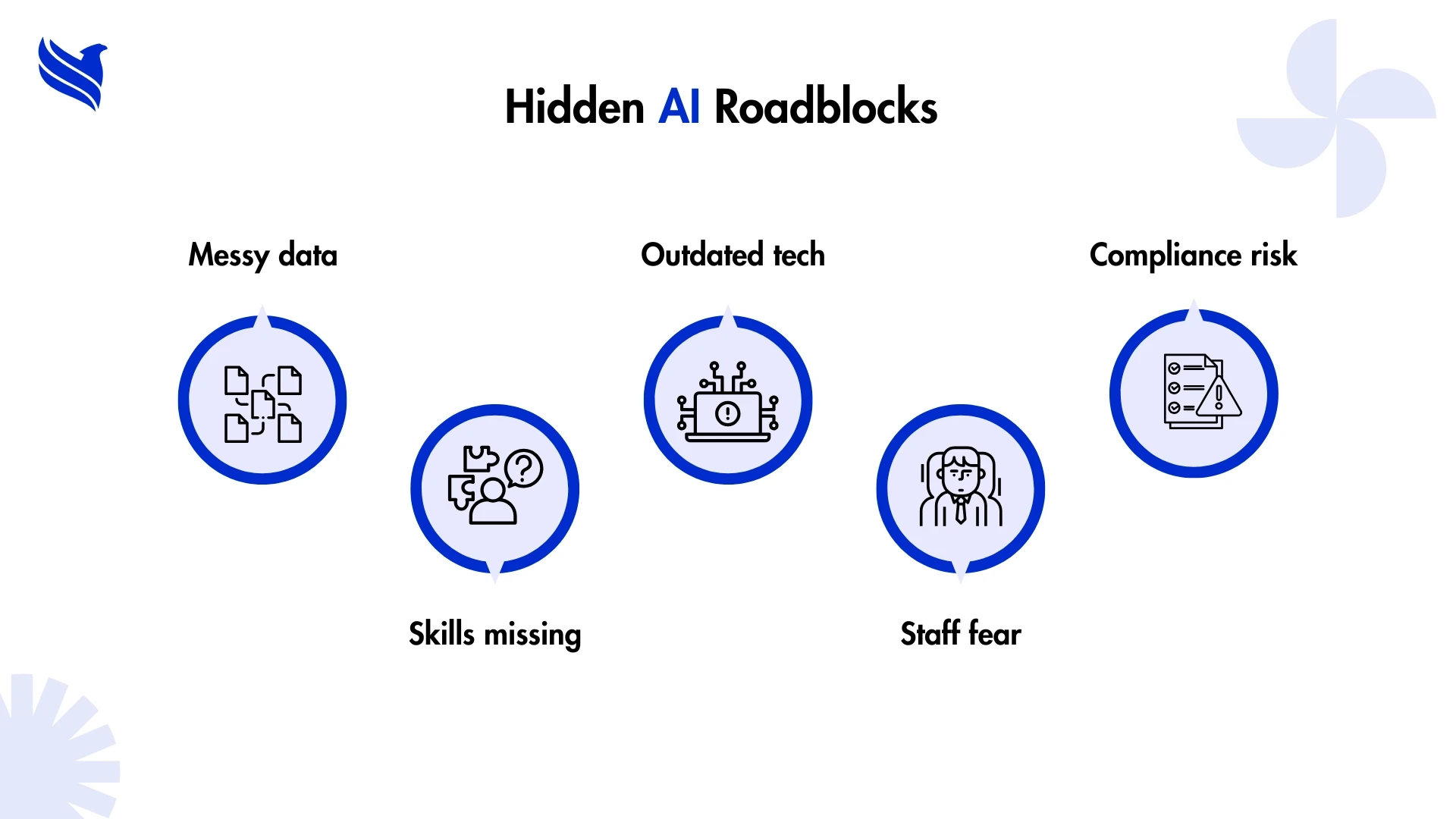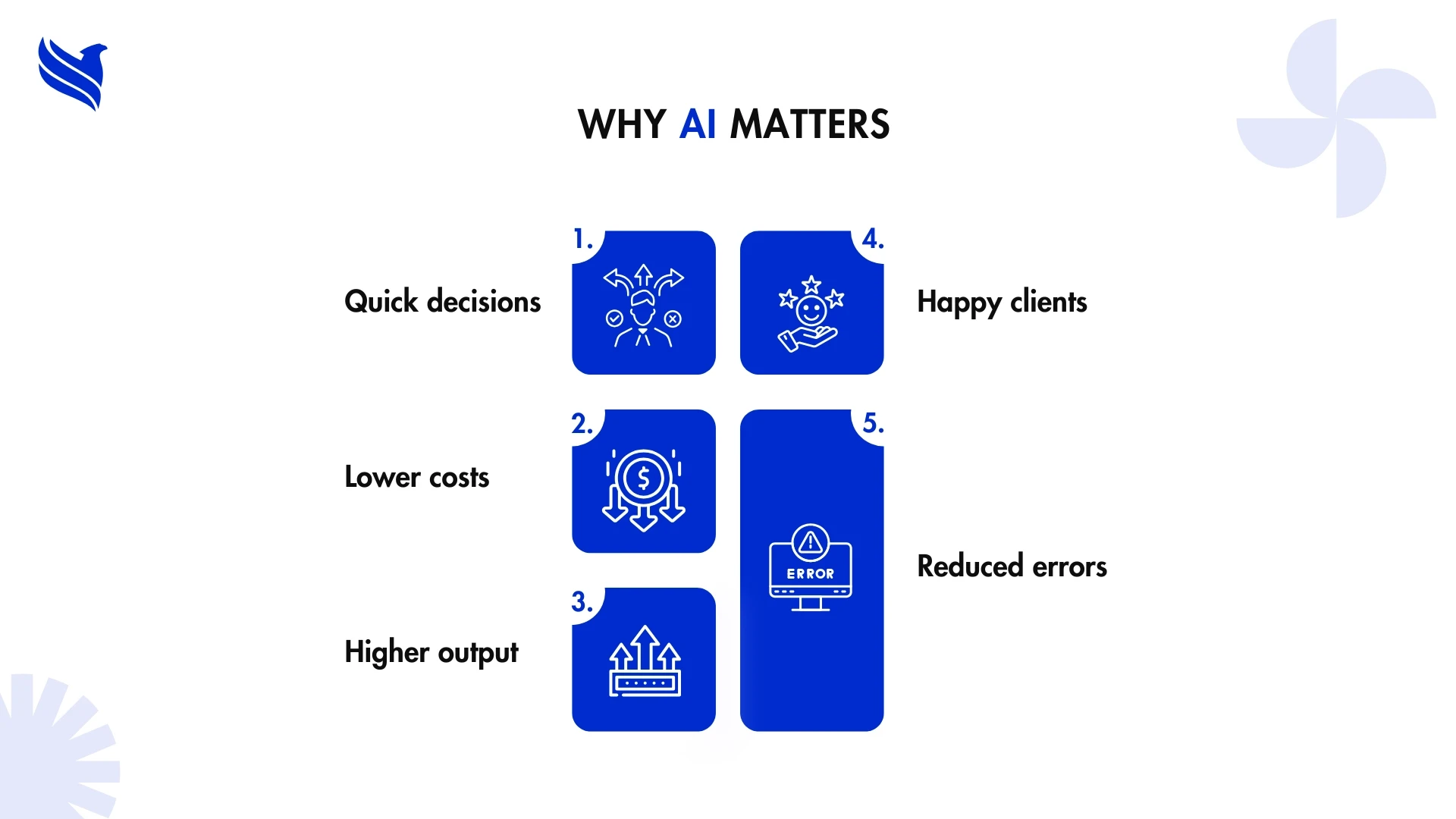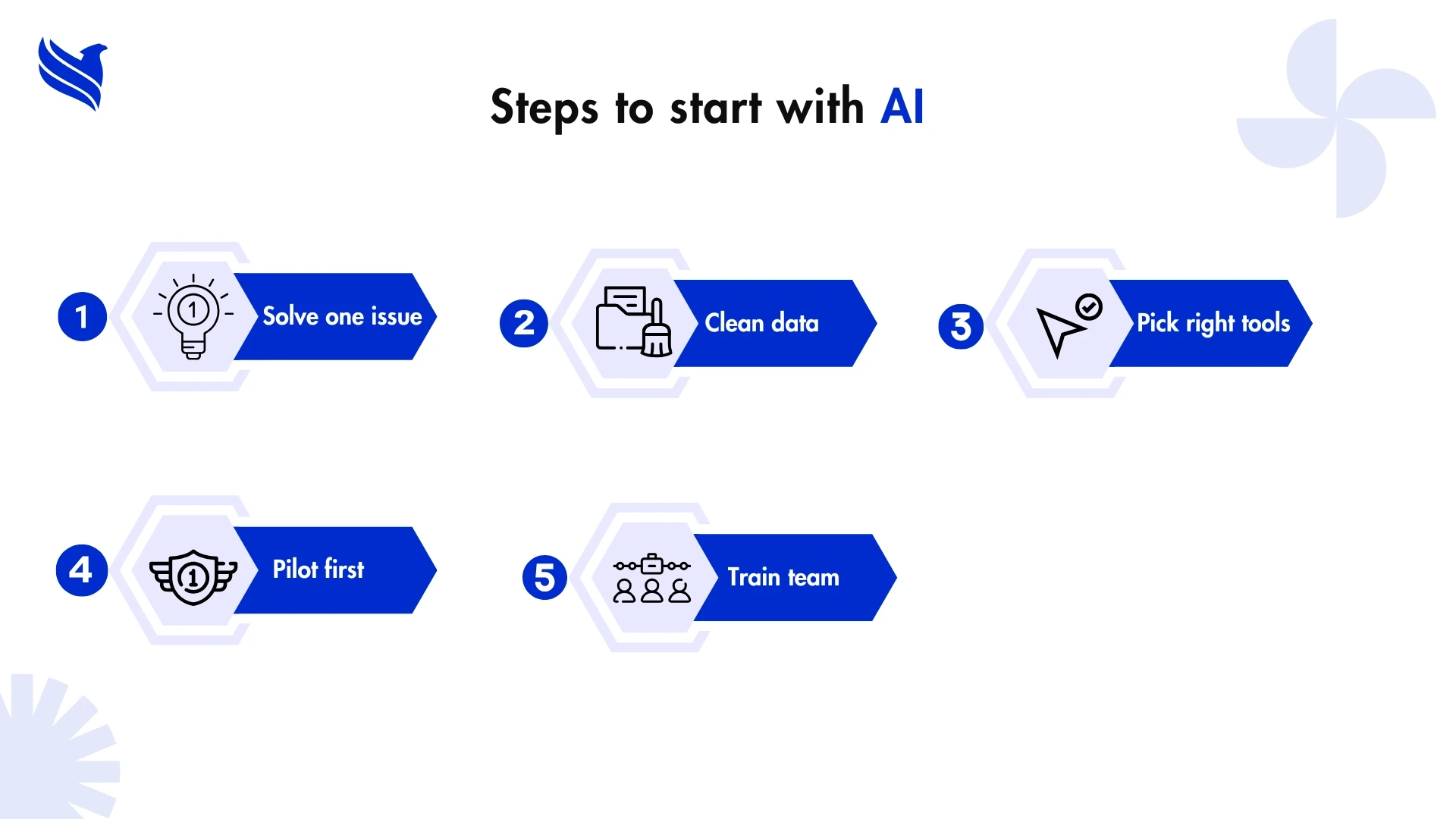Imagine standing at a crossroads: your business is growing, customers expect faster responses, and competitors are moving at digital speed, but your internal systems feel like they’re stuck in slow‑motion. That’s today’s reality for countless leaders. The challenge? Data grows faster than decision‑making. Human bottlenecks slow down opportunity. And overpromised ‘solutions’ often deliver underwhelming results.
- Hurdles on the road to smarter business
- How businesses are actually using AI
- What makes AI a real game changer
- Getting started without getting lost in the noise
- How AI changes the way work feels
- Looking ahead to what the future holds
- Why outsourcing and AI make a powerful combination
- Turning AI potential into business advantage
This is where AI application steps in, not as a buzzword, but as a genuine force multiplier. Think real‑time demand prediction, intelligent customer support, and personalized sales outreach. Yet, most companies don’t wake up one morning and magically implement AI. They face unclear direction, high upfront cost, and fear of failure, especially in small to mid‑size organizations.
In this blog, we cut through the hype: you’ll get a blunt and actionable view on how AI is used in business, explore the impact of AI on business, and see exactly how to implement AI in business, particularly for ai for small business owners who must make every rupee count. You’ll also read about Operational Efficiency Through AI Automation, the unfolding Future of AI in Business, and a smart note on how outsourcing AI services can help bridge skills, time, and budget gaps.
We won’t gloss over the hard parts; we tackle them head‑on. And yes, outsourcing gets a shout, because you don’t always need to build an entire data science team in‑house to make AI work. You can partner, iterate fast, and scale smart.
If you’ve ever asked yourself “how can AI help my business?”, or tried to figure out “how to implement AI in business” without feeling overwhelmed, you’ll want to keep reading.
Hurdles on the road to smarter business
Here’s the truth: adopting AI feels like diving into the unknown. There’s substantial promise, but also real friction. Let’s break down the common pain points that trip up businesses:
a) Data fragmentation and quality issues
Most companies aren’t running clean, organized data warehouses. Their information lives scattered: spreadsheets here, siloed CRM records there, shipment logs somewhere else. AI thrives on reliable data, garbage in, garbage out. Converted PDFs, inconsistent labels, missing values: all of this can cripple early machine learning efforts.
b) Talent gap and skills shortage
You may want to hire a data scientist or ML engineer, but the market for these skills is tight, expensive, and often beyond the budget of AI for small business owners. Even if you find capable talent, aligning them with domain experts, IT, and actual business needs is a cultural hurdle. Without strong internal champions, projects stall.
c) Unclear business case or ROI
Leaders often start with AI because it sounds sexy, without a clear plan or measurable outcome. Will AI reduce costs by 20%? Will it lift sales by 5%? If you can’t answer a simple question like that, your project risks becoming a science experiment that never earns back the investment.
d) Integration complexity
Legacy systems, especially in established firms, are brittle. Plugging in AI tools, predictive models or automation pipelines often requires building fragile custom connectors or rebuilding large parts. Huge hidden costs crop up when the AI tool can’t talk to your ERP or CRM reliably.
e) Change management and employee resistance
People fear loss: of jobs, autonomy, or control. Rollouts fail when employees see AI as a threat, not a tool. Without clear communication, training, and participatory design, resistance builds. And when front‑line staff hold up adoption, even the best technology stalls.
f) Ethics, compliance, and bias concerns
Algorithms can quietly inherit bias from the data they learn from. That’s how hiring tools overlook strong candidates, loan systems block deserving applicants, or customer segmentation misses the mark. In tightly regulated spaces like finance and healthcare, this is a serious problem. Rules are getting tougher, and if you can’t explain how your model reached a decision, you’re inviting legal risks and losing the confidence people place in your business.
As you can see, the path to AI isn’t just technical, it’s human, strategic, and organizational. But none of these obstacles is unfixable. In the next sections, you’ll see stories of how businesses overcome these barriers, apply AI with real impact, and scale smart. We also dive into how outsourcing can make this journey faster and less risky, without compromising outcomes.
How businesses are actually using AI
AI isn’t some trend waiting to arrive. It’s already here, woven into the daily grind, often running so quietly that no one stops to think about it. Instead of sitting in the spotlight, it chips away at the dull, repetitive work that used to drain hours. It’s not flawless, nothing is, but it clears room for people to focus on choices and moves that actually push the business ahead. Here’s where its presence is being felt the most:
Customer service
Those website chat windows that used to frustrate people? They’ve grown smarter. They now handle most of the basic queries, order tracking, simple troubleshooting, while routing complex problems to actual agents who can solve them. The result is faster responses without overloading support teams.Sales and marketing
These days, AI quietly digs through mountains of data, every purchase, every click, every interaction, and spots the prospects that are actually worth a call. Marketers take those insights and quickly see which campaigns are pulling their weight and which ones are just burning cash. It’s not magic, but it cuts down the blind guessing and helps teams stretch every bit of their budget further than they thought possible.Inventory and supply chains
Stockouts and overstocking used to be constant headaches. AI helps predict demand, showing what’s likely to run out and what’s sitting too long. This keeps inventory moving without tying up cash in unnecessary stock.Finance
Accounting teams use AI to automate data entry, flag inconsistencies, and check transactions. What once took hours of manual effort now gets done with fewer errors and far less time.Hiring
Sorting through hundreds of resumes is a drain. AI-powered screening tools help filter candidates based on skills, not just keywords, saving managers hours while improving the quality of shortlists.Product development
Instead of relying solely on gut instincts, businesses now use AI to track market signals and customer feedback. This helps them decide which features to build and which to drop, often faster than competitors.
For small businesses, the story is different. It’s not about big, flashy AI platforms; it’s about taking the weight off daily operations. The right tools help owners reclaim time, reduce mistakes, and focus on running the business rather than fighting fires.
Industries with heavy processes, like insurance, have been early adopters. They’re already seeing measurable benefits, from claims handling to risk assessments. For a closer look at how that plays out, check this detailed piece: Top 5 AI use & applications in the insurance industry 2025.
What makes AI a real game changer
The question isn’t whether a business uses AI, it’s whether anyone notices the results. When done right, the improvements are easy to spot, even if they don’t make headlines.
1. Decisions come quicker
Instead of waiting for reports to be compiled manually, data insights are ready when leaders need them. This speed lets businesses act while opportunities are still there.
2. Costs drop naturally
Savings don’t come from cutting corners; they come from cutting wasted hours. Repetitive tasks get handled faster, leaving more time for valuable work.
3. Teams produce more
With AI taking over the tedious parts, the same team can achieve more without feeling stretched to the limit.
4. Customers notice the change
Interactions feel more personal and relevant. Businesses respond faster and in ways that customers actually appreciate.
5. Mistakes go down
Manual errors, missed entries, wrong data, overlooked checks, get caught before they cause damage. That kind of reliability builds trust.
6. Growth feels under control
Scaling up no longer means chaos. With AI covering the basics, teams can focus on growing without burning out.
AI doesn’t simply work because you plug it in. It needs solid data to learn from, clear goals to aim at, and people who are ready to guide it along the way. When those elements click, it stops being hype and starts becoming something real, something a business can lean on to drive progress.
Getting started without getting lost in the noise
AI adoption often gets overcomplicated. You read articles packed with jargon, consultants promising overnight change, and yet inside your own business, it’s still a question mark. The reality is far less dramatic. No business wakes up one day with a full AI setup running perfectly. It happens in pieces, one step at a time.
Here’s how you break it down:
Pick one real problem first
Forget the grand plans. Start where it hurts the most, something that wastes hours or drags down results. Maybe it’s the endless cycle of manual reporting or customer queries that never clear out. Solve one thing, prove it works, and build from there.Get your data in shape
AI is only as good as the data it feeds on. If your records are scattered, outdated, or incomplete, no system will save you. Clean it, organize it, and make it usable. It’s tedious but critical.Choose tools you can actually use
Businesses get burned by chasing the “biggest” solution. You don’t need complex setups with features you’ll never touch. Choose something that fits your size and that your team won’t struggle with.Start small with a pilot project
Test it on a small scale. A pilot lets you see results without betting the whole business on something new. If it works, expand. If it fails, adjust and try again.Bring your team into the process
No AI tool succeeds without people behind it. If employees feel pushed out or ignored, they’ll resist it. Train them, involve them, and make them part of the success.Keep a close watch and keep tweaking
AI is not “set it and forget it.” It needs monitoring and adjustments. Business needs change, data changes, and so should your AI setup.
When you look at it this way, AI stops feeling like an intimidating wall and starts becoming a ladder, you climb it one step at a time. The companies that take this approach actually see results, while those waiting for the “perfect time” keep standing still.
How AI changes the way work feels
AI doesn’t crash through the door and make a scene. It slips in quietly, almost like it’s not there at all. First, a report shows up quicker than you expected. Then a task that usually drags on is already done. Slowly, the backlog that used to hang over everyone starts to fade. That’s when you realize work feels different, and the change has been building right under your nose. The workday feels different.
Here’s what businesses notice when AI starts to settle in:
- The backlog finally clears – Those routine tasks that used to clog up the workflow, reports, data processing, scheduling, start finishing themselves. They don’t sit waiting for someone to push them through.
- Teams finally get to think – When the daily grind isn’t eating all their time, people can work on ideas, strategies, and actual problem-solving. They start contributing where it counts.
- Mistakes stop stealing time – Errors caused by repetitive manual work drop because the system handles those checks without getting tired or distracted.
- Projects move without delays – Instead of pausing for small steps to be done, the work flows. Teams aren’t waiting around for the basics to catch up.
- Growth doesn’t feel like chaos – The company can take on more without everyone feeling like they’re drowning. Hiring becomes a choice, not an emergency.
- Employees use their real skills – People focus on the parts of their job where they add the most value, while the routine is quietly taken care of in the background.
This shift goes far beyond saving a few hours on the clock. It changes the way teams feel about their work. The constant pressure eases because those small mistakes and bottlenecks that used to slow everything down start disappearing. People notice that their energy is finally going into work that counts, not the same dull tasks over and over.
Give it some time, and you can see the gap it creates, a company that’s always chasing its tail versus one that actually has the breathing room to plan, improve, and grow. AI isn’t here to take away the human part; it’s clearing the space for it. When people aren’t buried in the grind, they think sharper, come up with better answers, treat customers better, and drive the kind of progress no software could ever pull off on its own.
Looking ahead to what the future holds
AI has already slipped into everyday business tasks, and it’s not going to stop there. Right now, it’s doing the heavy lifting on routine work. In the coming years, it will dig deeper into planning, decision-making, and spotting where companies should head next. This change won’t hit all at once; it will build up in layers.
Here’s how the future is likely to unfold:
- Tools anyone can handle – The complicated setups of today will give way to software that’s easier to work with. Businesses won’t need entire tech teams just to keep things running.
- Teams sharing the same picture – Instead of departments hoarding their own data, AI will pull everything together. Decisions will be made with a full view, not with fragments.
- Service that feels human – Replies to customers won’t be scripted or slow. They’ll be quick, fitting, and closer to what people actually expect.
- Ethics shaping the rules – Companies won’t be able to ignore fairness and privacy. How they handle these concerns will decide how much people trust them.
- Opportunities that weren’t visible before – AI will reveal patterns and open doors that were easy to miss. That could mean new markets or products no one thought of yet.
- Humans still calling the shots – Machines can process data, but people set the direction. Businesses that remember this will make better use of the technology.
The companies that try, learn, and keep adjusting, rather than waiting for the perfect plan, will be the ones ready for what’s coming.
Why outsourcing and AI make a powerful combination
Here’s the thing, AI is everywhere now, and every business owner is told they need to “get on board or get left behind.” Easy to say. Harder to pull off. Most small or mid-size teams don’t have spare millions lying around to hire data scientists or a crew of engineers. Even if you did, training them, building systems, keeping them from being poached, that’s a full-time headache.
Many business owners try to go it alone. They buy tools, throw them at the team, hope magic happens. It rarely does. Instead, the project drags on, costs balloon, and at the end of it they’re left with half-working software and a staff that’s frustrated. That’s why outsourcing feels like a lifeline when you hit this wall.
You’re not paying outsiders to learn on your dime; they’ve already climbed the mountain. They’ve built and broken systems enough times to know where the landmines are. While your team stays focused on what keeps the lights on, theirs is buried in the tech, fixing things before you even know there was a problem.
Costs? Sure, outsourcing isn’t free, but it’s nothing compared to the money burned building in-house from scratch. Especially for smaller businesses, this is the only way AI adoption makes sense. You get access to talent you’d never afford otherwise, without chaining yourself to endless payroll overhead.
And speed. God, the speed. These guys have playbooks. They roll out tools, tweak models, get things working fast because they’ve done it a hundred times. No months of trial runs. No endless delays.
Another thing no one talks about, AI doesn’t just work forever once you set it up. It drifts. Models get outdated, data changes, updates break stuff. In-house teams rarely have the time to babysit it all. Outsourced partners? That’s their entire job. They keep things tuned while you focus on customers, products, and growth.
When it all clicks, outsourcing isn’t just about saving money. It’s about building a base you can actually grow on. You get tools that work, guided by people who know how to squeeze results out of them, while you stay locked on what matters, running your business.
Turning AI potential into business advantage
AI is not something you can keep ignoring. It’s here, and it’s changing how companies run, everywhere. You can see the difference in businesses using it well: decisions made faster, customers sticking around, teams not drowning in grunt work.
But there’s a catch. Jumping in blind is a mistake as we have watched companies burn cash chasing shiny tools with no plan. The winners? They start small. They pick something that matters, test it, learn from it, and scale from there. They keep the team involved, because tech without people behind it doesn’t stick.
This is where outsourcing quietly changes the game. Instead of spending months figuring out how to get started, you get people who’ve done it all before. They handle the hard stuff so you can focus on results. You’re not stuck in technical weeds; you’re watching things actually work.
That’s where FBSPL comes in. We have been on this road long enough to know the pitfalls. We help you take that first step, and the next, and the one after that. Whether it’s automating the dull stuff or pulling insights out of data you didn’t even know you had, the right AI approach opens doors you didn’t see coming.
Ready to leverage AI for smarter decisions and faster growth? Partner with FBSPL to turn AI insights into real business outcomes.

